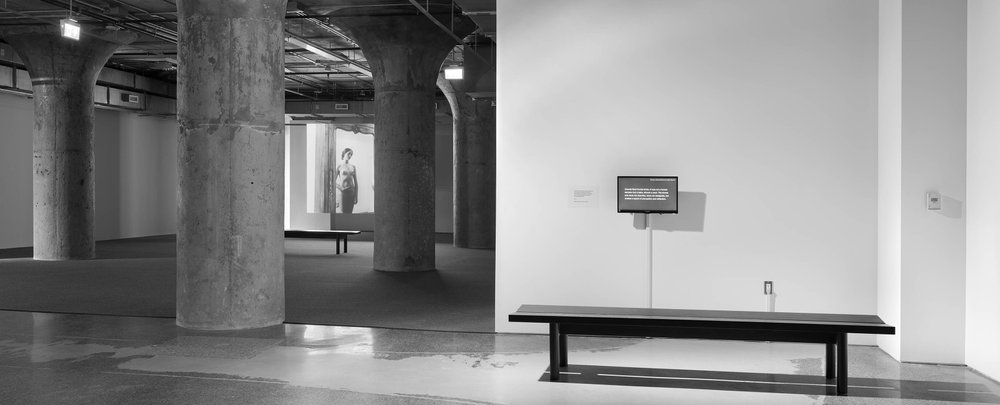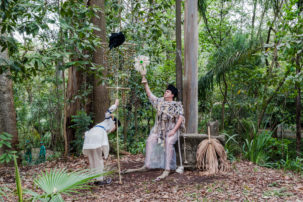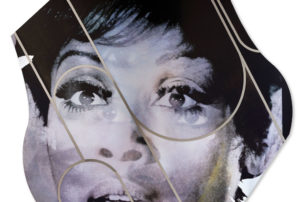Chantal insisted that the spectators do their own work. She used to say that she wanted people to feel the passing of time in her films. When someone said, “Oh, I just saw a great film, I didn’t notice the time passing,” she did not think that was a compliment. She felt that the spectator’s time had been stolen. In editing, we never said, “Look, there we need a long shot.” We chose the duration intuitively, and we understood later why. It is as if the shots themselves imposed their duration. Chantal liked to recount how we would hit the table at exactly the same moment to indicate that it was necessary to cut the shot. We saw the same things.
—Claire Atherton, “Tribute to Chantal Akerman,” 2015
Film editor Claire Atherton met legendary artist and filmmaker Chantal Akerman in 1984, when Atherton was just 21, and they collaborated together until Akerman’s death in 2015. Throughout her career, Atherton’s precision, dedication and insight into the chemistry of moving images has led to her working with renowned artists and directors. In 2013, the Grenoble Cinemathèque honoured her with a retrospective of films she has edited. On the occasion of a new exhibition of works by Akerman at the Museum of Contemporary Art Toronto Canada, Atherton discusses the substance of film editing, somatic ways of seeing and her profound artistic relationship with Akerman.
Yaniya Lee: How has it been for you transitioning from film to an art context, where the works have been presented as installations and sometimes triptychs. Can you talk about the difference between editing for film and editing for installation? Does this mean a different way of thinking when producing the work?
Claire Atherton: I am not sure it’s a different way of thinking. But it is a little bit a different way of working. When you edit a film, you put images and sounds after each other and you create a narration which is built in time. Every film has a beginning, a middle and an end. For an installation, the relationship to time is different because the audience can arrive or leave at any moment. So the space became part of the narration. It was like adding a new dimension to our editing work.
YL: You’ve spoken about the way that you put films together and explained that it’s not just film or sound, but that you’re working with something else. I think you referred to it as matière, or matter. Can you talk about that?
CA: Yeah, I don’t think it’s matter. I’ve never found any translation for matière. The water is a matière, the wood is a matière, but the computer is not.
YL: It’s more like substance.
CA: It could be substance or texture or something like that, but there is something mysterious about it also. I never found the right translation. It seems the word doesn’t exist in English! That’s why I keep using the french word matière. Material is dead, it’s still: matière is alive. Images and sounds are alive. They have their own secrets, they have their dignity and you have to respect them. By respecting your images, you also respect the people who are filmed. I am not using images in the purpose of a meaning; I listen to them, I feel them, and I try to understand where they are leading the film.
Some people think that in editing, first you choose the scenes that you are going to include and you find the structure and then you work on the rhythm. For me, that’s impossible. The narration is organic. It comes from the shocks, the contrasts, the colours—it comes from the rhythm itself. When I was working with Chantal, it was very important for us not to know where we were going. It’s what we used to call “discover while doing.” We were ready to be lost during the process, and to understand the meaning of the film little by little. The process of editing has to stay mysterious and surprising until the end of the work; it has to stay alive, so that the film stays alive after it’s finished. If you know too well where you want to go, you don’t feel like going anymore. A film that stays alive is a film that is not locked in a particular signification, but which creates different feelings, different meanings, different links for each viewer.
Sometimes I’ve been asked to compare editing to writing. Some people say that a film is written during the editing. In some ways this is true. But I feel there is something more physical, and more instinctive in editing than in writing. The words are more linked to an immediate meaning than the images. And as I told you before, I need to work with this “non-meaning” dimension, because meaning often disengages the senses. I like more the idea of shaping. Editing has a lot to do with weight and lightness. I like to compare editing to sculpture.
YL: Could you talk about working with Chantal? How did that relationship develop? It seems like editing is all about trust, about being on the same page. In the tribute piece included in the exhibition, you talked about this synchronicity in seeing that you shared with Chantal, that you came to see things similarly when you were editing and making those choices.
CA: In fact it came very quickly. When I met Chantal I was working as a technician in the Centre audiovisuel Simone de Beauvoir in Paris, whose purpose was archiving and producing women’s films. I didn’t want to go to art school, I didn’t want people to teach me how to think. I wanted to work, and I liked technique, because I felt it was a concrete relationship to things. One morning, Delphine Seyrig, a famous French actor who was the president of the Centre, called me. She and her niece Coralie Seyrig were performing in Letters Home at the time, a play based on Sylvia Plath’s diary. Delphine asked me to go with Chantal to record it on video for French TV. I was supposed to bring the camera and do the focus. After five minutes of filming, Chantal told me, “I’ll focus because I don’t feel well installed. You hold the camera!”
YL: She trusted you.
CA: I don’t know if she trusted me yet. But probably in a way. She was so quick and intuitive! She just said, “I don’t feel like doing it, so you do it!” And I did it…everything seemed possible with her. I didn’t even have time to feel fear. I was so young! Twenty-one years old. We didn’t speak much, but every time I was moving in one direction, or zooming in a little to get closer to Delphine or Coralie, she was about to tell me to do so. There was something so simple and immediate between us. It was a magical meeting. After shooting, she was very excited; she said that we were feeling things the same way and that she wanted to work with me. Since that moment, we trusted each other, always. That was in 1984.
During that period, I was very interested in Taoism and Chinese civilization. In the Chinese language, the association of images creates a signification. That’s the basis of editing! For example, the moon associated with the sun means brightness; a little pig under a roof means home. Also, for Taoists, process and effect are linked, and signification comes from movement. Emptiness is the place where transformations can happen, where links can be made; it’s the place that makes movement possible. I was fascinated by this writing and this way of thinking, but I wasn’t aware of all those links between Chinese thinking and editing when l began to edit films. It was much later, when I’d been asked to put my practice into words, that l realized the influence it had on my work.
I am telling you all that because it’s important for me to say that I didn’t study editing. I don’t know how I became an editor. In the world that we are living in, each time you want to do something people ask, “Why do you want to do that?” and “Are you sure you want to do it?” and also “What’s your message?” or “What do you want to do with your life?” That’s terrible. I didn’t plan what my life would be. I liked mathematics, sciences, I liked Chinese. And all of this led me to be an editor and to meet Chantal.
If you let things come to you and you’re in a receptive position, things can happen, chance can happen. That’s true in art also. Art is not supposed to tell you what to think, and it’s not supposed to give you any message—it’s supposed to help you to think by creating emotions and feelings. If you are in a receptive position, art can raise questions, help you to hope again and to feel that humanity is still alive.
YL: That’s exactly how you described working together to make these films that don’t promise all of the answers. They just present scenes, textures, colours, sounds…
CA: Yes, exactly. I think the creation process is linked to the form of the film or the artwork. And it’s also linked to the way you live. That’s why I say that everything is political.
For example, in Chantal’s exhibition on the second floor here [at the MOCA], I don’t feel that Now is more political than In the Mirror. Now talks about war and the end of humanity, so of course it’s political. But to see this almost naked woman looking at herself in the mirror and talking about her body, criticizing her body, it can raise questions about our own relationship to women’s bodies, or about what society expects from women’s bodies. This is also political.

Chantal Akerman, In the Mirror, 2007. 16mm black-and-white film transferred to digital format, 14 min 21 sec. Installation view at MOCA Toronto. Photo: Tom Arban Photography Inc.
YL: Do you have a story about Chantal that you would like to share? You had a unique relationship with her in terms of the way that you worked together.
CA: I have many stories!
YL: Well, then what does it mean to continue this legacy? I know you made this work together but now you’re more responsible for presenting it, and for speaking about it. I mean, you’re still very devoted to this project in a way.
CA: Of course I’m still devoted to this project. It’s like keeping her alive with us. Chantal’s work is so important. I want to say as much as possible that her work is not complicated. It’s complex, but it’s not complicated. Some people think that they have to study cinema for five years to see one of her films, to know what they have to understand. It’s absolutely not true. You don’t have to know anything, you just have to be open. You have to be ready to jump, even if you feel a little lost sometimes. Don’t try to understand everything right away, but listen to your feelings and your sensations. What you feel builds your own way of facing yourself and facing the world. And if you get bored sometimes, if you wait for something to happen, it’s also a way of being alive. Chantal didn’t know anything better than her audience. Her work is an experience. It’s a way of living. You don’t just look at her films only through your eyes, and you don’t understand them only with your head—you live her work with your whole body.
It’s important for me to take care of the installation of the works, because each time it’s different, each time I discover something. I realized only yesterday, when everything was finished, that the contrast between the still pillars—that we had to deal with here [at MOCA] because they are part of the building—and the moving images of the tracking shots was very strong. I thought, This brings something more. It adds to it. I won’t say I will ask for pillars next time, but I am always open to what might happen…
One thing that I can share with you is the story about the curtains. When we were editing South, we decided that we would only work in the afternoons. I came for lunch, then we worked a few hours, and then we had a glass of wine around 6 pm and worked a little bit more. In the morning we were staying at home and doing our own things. Often Chantal would ask what I did in the morning. One day I had made curtains. She was so surprised! She said: “You made your curtains all by yourself?” I said, “Yes, I just bought a sewing machine, it’s not difficult.” And she said, “I’m so impressed! Much more than if you had won the Oscar for best editing!” Chantal could be very funny. People don’t know that so much. But it was true, it was not meant to be funny.
YL: It was sincere.
CA: Yes it was sincere. She didn’t have any code of behaviour, she was just living.

 Chantal Akerman, In the Mirror, 2007. 16mm black-and-white film transferred to digital format, 14 min 21 sec. Installation view at MOCA Toronto. Photo: Tom Arban Photography Inc.
Chantal Akerman, In the Mirror, 2007. 16mm black-and-white film transferred to digital format, 14 min 21 sec. Installation view at MOCA Toronto. Photo: Tom Arban Photography Inc.





